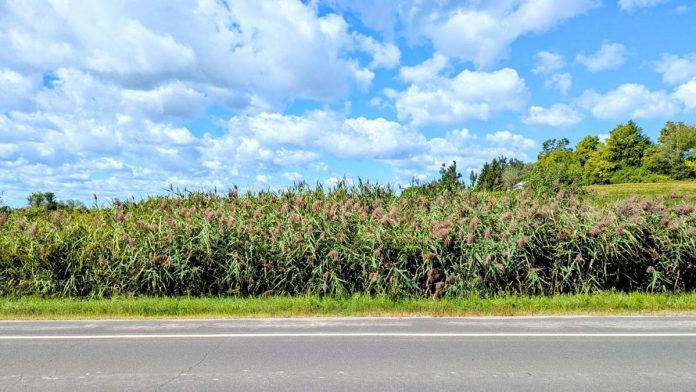
Peterborough County is getting help to track the presence of an invasive grass called phragmites (pronounced frag-MY-tees) that’s endangering the local ecosystem.
The county has received a grant through the Invasive Phragmites Control Fund, a program of the not-for-profit Invasive Species Centre supported by the Ministry of Natural Resources that provides grants ranging from $2,500 to $50,000 for local on-the-ground action on phragmites.
According to a media release from Peterborough County, the grant will go towards mapping invasive phragmites along county road allowances, and “help assess the best methods and resources needed to develop a management plan.”
“Protecting the health of our wetlands, shorelines, and infrastructure is critical to maintaining the environmental and economic sustainability of our region,” said Peterborough County Warden Bonnie Clark. “This funding allows us to understand the scope of the issue better and plan strategically for the future.”
A perennial grass that was introduced to Canada’s coastal regions in the 19th century, phragmites spreads aggressively by outcompeting native vegetation for water, sunlight, nutrients, and space. It become well established across Ontario by the 1990s and currently poses a major threat to the ecosystem, including wetlands and shorelines.
Phragmites reduces biodiversity and surpasses native vegetation, lowers water levels in wetlands and shorelines, and threatens species at risk that rely on those habitats. It also blocks sightlines for motorists and obstructs road signs, impacts drainage systems, and damages roadside infrastructure.
In Peterborough County specifically, phragmites has been found not only near wetlands and waterways, but also within roadside ditches and agricultural lands, interfering with visibility, drainage, and soil stability.
With the support from the Invasive Phragmites Control Fund, Peterborough County has developed a mapping application to record phragmites populations along county road allowances. The county is collecting data that includes population size, density, hydrological conditions, and whether the species is present on public or private land.
By enabling the county to visualize the scale of the phragmites issue and overlay additional information, such as provincially significant wetlands and ongoing eradication efforts from partner organizations, the mapping initiative will guide the development of a phragmites management program that follows best practices.
The Invasive Phragmites Control Fund is part of the Invasive Species Centre’s Ontario Phragmites Action program, which encompasses a collaborative, province-wide effort to combat the impacts and spread of invasive phragmites. Supported by the Ontario Ministry of Natural Resources and Forestry, the Invasive Species Centre and the Nature Conservancy of Canada lead the program alongside a network of partners.
According to the Invasive Species Centre, invasive phragmites spreads quickly by releasing biochemicals from its roots into the soil, hindering the growth of surrounding plants. The grass also grows in stands that can be extremely dense, with as many as 200 stems per square metre, that crowd out other species. Reaching heights of up to five metres, the stems are tan in colour with blue-green leaves and large, dense seedheads.
One of the issues in identifying invasive phragmites is the fact that there is a closely related native subspecies. Native phragmites does not grow as tall as the invasive species, and in less-dense stands that are frequently mixed with other plants. The stems are usually more reddish-brown in colour with yellow-green leaves and smaller, sparser seedheads.
To learn more about invasive phragmites, visit invasivespeciescentre.ca.


























